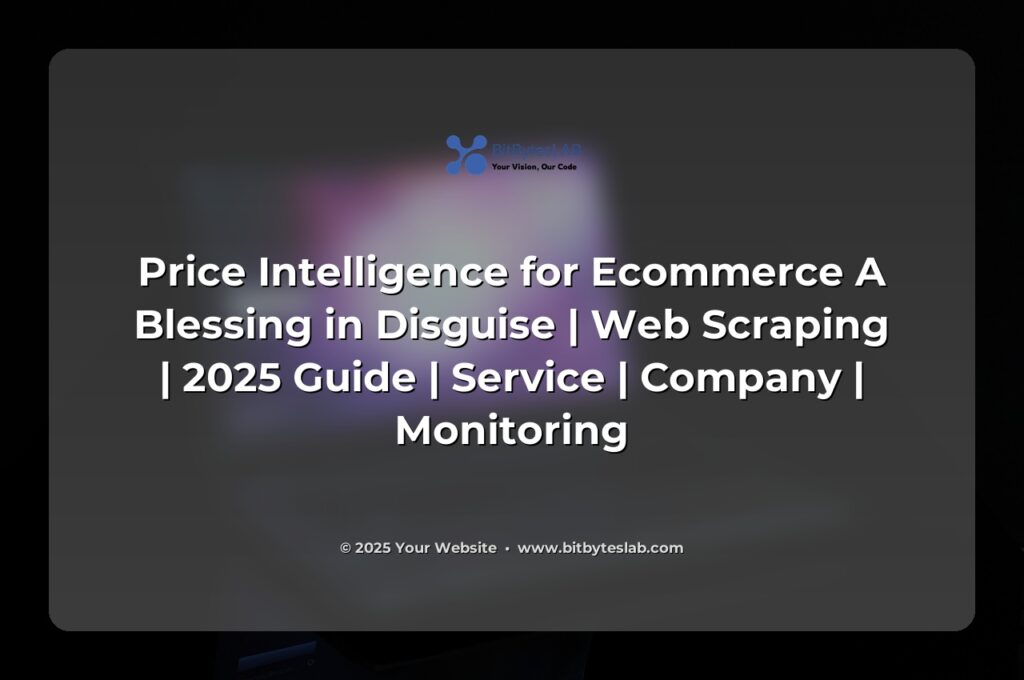Ever felt like you’re chasing your own tail in the endless jungle of online prices? That’s the reality of every e‑commerce strategist in 2025—prices change faster than a meme’s popularity, and if you’re not in real‑time, you’re already behind the competition.
Why Price Intelligence Is the New Currency
Retailers who have built dashboards that pulse with live pricing data are the ones who can adjust margins on the fly, launch flash sales just before a competitor drops a price, or preempt a price war without a single spreadsheet update. In fact, a recent study found that companies with automated price intelligence saw a 15 % increase in gross margin over a single quarter—proof that data isn’t just good, it’s profitable.
What Is Price Intelligence, Anyway?
Think of it like a multi‑sensor observatory. You gather hundreds of data points from Amazon, Walmart, niche marketplaces, and even international competitors. Then you harmonize the units, currencies, and product identifiers so you can compare apples to apples. The cherry on top? Automated alerts when a price dips below a threshold or when a new competitor enters the market.
At its core, price intelligence is a marriage of data extraction (web scraping), data hygiene (normalization, deduplication), and analytics (visual dashboards, predictive models). It transforms a clutter of HTML into a crystal‑clear KPI that feeds into dynamic pricing engines, margin calculators, and even e‑commerce compliance checks.
Because the data lives online, the extraction layer is key. But not just any scraper—modern sites load content via JavaScript, use infinite scroll, and employ anti‑bot measures. That’s why headless browsers and distributed scraping stacks are the new normal. They let you mimic a human shopper, bypass CAPTCHAs, and pull data from even the most guarded storefronts.
Once you’ve got the raw content, the real power emerges in normalization: converting USD to EUR, handling “$1.99” vs “1,99 €”, mapping SKUs to ASINs, and deduplicating listings that appear under multiple titles. It’s the difference between a messy pile of numbers and actionable insights that can be fed directly into your pricing models.
And let’s not forget compliance—robots.txt is no longer a suggestion, GDPR, CCPA, and site TOS are legal hurdles that can bite you hard if you’re not careful. A compliant stack means transparent logging, IP rotation, and an audit trail that would make any regulatory body smile.
In practice, you’re looking at a pipeline that starts with a scheduled crawl, runs through a distributed worker cluster with proxy rotation, normalizes data with a single schema, stores raw HTML for future re‑processing, and feeds the clean data to your analytics layer. The result? A real‑time dashboard that shows you the market snapshot and alerts you to opportunities—and threats—before your competitors even notice.
What’s the bottom line? Price intelligence isn’t a nice‑to‑have feature; it’s the core logic that keeps e‑commerce brands profitable in a world where a 1‑second price lag can mean a lost sale.
💻 How many programmers does it take to change a light bulb? None, that’s a hardware problem! 💡

Expert Strategies for a Robust Stack
1️⃣ Start with a “Discovery Sprint.” Before you even write a line of code, map out the target sites, identify the data points you need (price, currency, availability, SKU), and sketch a tentative schema. Use tools like Screaming Frog or built‑in browser dev tools to drill into the DOM and identify stable selectors or JSON‑LD blocks.
2️⃣ Polite Scraping First. Respect robots.txt and set a realistic User‑Agent header. Add a short delay between requests to mimic human browsing. If a site signals you’re abusing the interface, pause and reevaluate.
3️⃣ Use Headless Browsers for JavaScript‑Heavy Pages. Modern storefronts render prices via AJAX. A lightweight headless browser (Playwright or Puppeteer) can wait for the price element, capture dynamic content, and even handle authentication if needed.
4️⃣ Deploy a Distributed, Container‑Based Architecture. Dockerize the scraper, orchestrate with Kubernetes, and employ autoscaling based on queue depth. This guarantees throughput during flash sales and reduces costs when traffic is low.
5️⃣ Implement a Robust Normalization Layer. Standardize currencies with real‑time FX rates, convert units, and map SKUs to a canonical identifier. Store both raw and cleaned data for reproducibility and audit purposes.
6️⃣ Set Up Continuous Monitoring. Create simple dashboards in Grafana or Tableau that track extraction success rates, response times, and anomalies. Use alerts (Slack, PagerDuty) for anything that deviates from the norm—price spikes, missing data, or increased latency.
7️⃣ Maintain Legal Compliance. Keep a log of all requests, document consent if you capture personal data (e.g., user reviews), and ensure data encryption at rest and in transit. A regular audit will keep your stack—and your reputation—clean.
Industry Insights & Market Trends
According to Gartner, by 2026, 70 % of e‑commerce brands will rely on AI‑driven price optimization. That’s not just about discounting; it’s about predicting demand, adjusting margins, and staying ahead of price wars. Companies like Shopify Plus are already offering pricing APIs that integrate directly with your own pricing engine.
Another trend is the rise of GraphQL APIs in retail tech stacks. Rather than scraping, some brands provide structured queries that return price, inventory, and promotional details. However, most marketplaces still hide critical data behind JavaScript, making scrapers indispensable.
Data privacy is also tightening. GDPR’s “Right to be Forgotten” now requires scrapers to delete any personal data they might have inadvertently captured. That means building your pipeline with data lifecycle management from day one.
And let’s not overlook the human side: 70 % of competitive analysts cite “data overload” as a bottleneck. A clean, normalized, and well‑visualized price intelligence platform turns noisy data into actionable insights—allowing analysts to focus on strategy rather than cleanup.
Bottom line: the future belongs to teams that can collect, clean, and react to pricing data in real time without breaking the law or the bank.
⚡ A SQL query goes into a bar, walks up to two tables and asks… ‘Can I join you?’ 🍺

Business Applications & ROI
Think of price intelligence as the engine that powers several high‑impact business functions:
- Dynamic pricing—adjust in milliseconds to competitive shifts.
- Margin optimization—identify underpriced SKUs and protect profitability.
- Promotional performance—measure the impact of discounts in real time.
- Fraud detection—spot anomalously low prices that may signal counterfeit listings.
- Market research—understand price elasticity across regions and channels.
Case studies show that retailers who implemented automated price intelligence realized an average 5–10 % lift in revenue within six months, while operational costs dropped by 25 % thanks to reduced manual spreadsheet work.
ROI is clear: the initial investment in a robust scraping stack pays off quickly through higher margins, faster go‑to‑market decisions, and the ability to stay competitive in a volatile pricing landscape.
Common Challenges and How to Beat Them
1️⃣ CAPTCHAs & Bot Detection. Use residential proxy pools and anti‑CAPTCHA services. Remember, a human touch—mouse movements, timing—helps maintain a low footprint.
2️⃣ Site Structure Changes. Implement selector‑agnostic extraction logic and keep unit tests that run against sample pages. When a selector fails, your pipeline should flag the issue and not crash.
3️⃣ IP Bans. Rotate IPs, set request limits per domain, and use cloud functions for distributed crawling. Spot instances can keep costs down while scaling on demand.
4️⃣ Currency & Unit Inconsistency. Store everything in a canonical unit and convert on the fly. APIs like Open Exchange Rates make real‑time FX easy.
5️⃣ Legal Pitfalls. Keep a compliance playbook: document each step, audit logs, and enforce data retention policies. A single breach can cost millions.
6️⃣ Data Quality. Duplicate detection via fuzzy matching, image hashing, and SKU cross‑referencing keeps your datasets clean and reliable.
Future Trends & Opportunities
2025 is shaping up to be the year of LLM‑powered extraction. GPT‑4 and Claude can parse entire product pages, even images, and return structured price data without hand‑crafted selectors. That will dramatically reduce maintenance overhead and enable rapid onboarding of new marketplaces.
Another frontier is edge computing for scraping. Running headless browsers on Cloudflare Workers or AWS Lambda@Edge minimizes latency and cost, especially for time‑critical pricing updates during flash sales.
Finally, the integration of price intelligence with AI‑driven demand forecasting. By feeding live price changes into a predictive model, you can forecast demand shifts before they happen—turning data into a proactive strategy.
Conclusion: Turn Blind Data into Bright Strategy
In a world where price changes flash faster than a pop‑up ad, having a reliable, compliant, and scalable price intelligence stack is no longer optional—it’s a competitive necessity. It turns raw, chaotic data into real‑time decision‑making power that can boost margins, fuel growth, and keep you ahead of the game. 🌟
Want to turn price intelligence into your secret weapon? BitBytesLab is your go‑to partner for premium web scraping and data extraction services. We build robust, compliant pipelines that keep your data fresh, accurate, and GDPR‑ready—so you can focus on strategy, not source code. 💪





